
In comparing the system of simple pictorial notation, of which the outlines have now been presented, with similar efforts to record ideas in other parts of the world, there is, doubtless, a class of testimony referred to, from which important deductions may be drawn. The art, as we hinted in first sitting down to this paper, was one of the earliest known to mankind; and without supposing that in the progress of human diffusion over the globe, it was in all cases derivative, it was indubitably so in many instances. In others, it would have been originated or fallen into by the mere similarity of early circumstances and opinions, among erratic or migrating tribes. It was the first effort of men to transmit thought. Fear is perhaps the primary passion among rude nations. The Mysterious Power which governs the universe, as manifested in the phenomena of the heavens, has led all nations, however obscure, to adopt some sort of worship, and this was ever a prominent and leading motive. Whatever other passion or sentiment conspired to the institution of early religious rites, fear was most clearly the predominating cause. Wonder and superstition were at hand. The early history of men shows, that the first propitiatory offerings were made on this basis. What nations dreaded they worshiped, and the first step was to draw a picture of the object, or to symbolize the idea of it under the representation of some material form. In this manner the sun and the moon became at so early an epoch objects of almost universal adoration throughout the oriental world. The honors they received as symbols of a Higher Principle, they did not, however, permanently retain. They, in their turn, were symbolized by celebrated men; and thus Persia and Egypt, Hindostan and China, and other quarters of the eastern hemisphere, were filled with their ruling deities, under the human form, and their kings and rulers traced their descent or relationship to these two luminaries.
In every case these nations mistook a picture for a god. “We regard this as the element, or unit in pictorial writing. If they feared the Power which appeared to govern the elements, they also feared those, more. prominent and gigantic forms of the animate creation, which filled the earth, the any or, the seas. When they captured one of these prime animals, reptiles, or birds, they perpetuated the triumph by a figure, or picture of it.. There was at once an ideographic record, but it was exclusively a record of substantives. Action was communicated to it by auxiliary figures of men and implements, trees and plains. For time, a dot would answer, and for arithmetic, a stroke. Such, we imagine, to have been the inception of the system. That it was susceptible of rapid improvement, and came to express a considerable sum of information, we have only to glance back at the preceding details to show. How soon the pictorial method ran into the true hieroglyphic, and the latter into the alphabetic, it would be very curious and instructive to inquire; but it is an inquiry which we must forgo. For had we the requisite materials, it would demand all the space we propose to allot to the present outlines.
By the notices taken of the Egyptian system of hieroglyphic writing, an important link in their notorial chain of progress is shown. The thought occurred to the skilful hierophant that a picture might stand for, an articulate sound of the human voice. And the system- Adapted was, that the picture of the bird, animal or other object, so drawn; to denote a sound, should represent, exclusively, the first or initial letter of the name of the object depicted. The discovery of this principle was: the great revelation of modern times in Egyptian hieroglyphics, and has opened a large amount of information on the later monuments.
The Chinese system of writing is also based on, and has grown out of, the pictorial and the hieroglyphic. . But it -has assumed the most cumbrous and complex possible form for the communication of ideas; and one that is least favorable to the progress of the human mind. It constitutes the great objection to the phonetic system- that objection which introduces it all its uncertainty, and continues to make it a subject of labor and agreement among the learned that there is a great multiplicity of its homophonous characters. The Chinese ran into a very unique system of recording thought, one which ensured great precision and certainty, but imposed on the learner a most, extraordinary labor. It was to invent symbols for the sounds of whole words, terms and even phrases, instead of elementary sounds. Every noun-symbol, and every verb-symbol, and every pronoun-symbol was provided with adjunct characters, to denote accessory meanings, so that the Chinese alphabet is an alphabet of whole words, and not, as with us, and all other modern nations, an alphabet of elementary sounds. Eighty thousand characters to record a language, instead of twenty-six. That a nation with such a system should not progress in knowledge, and that the pursuit of it should be highly valued, excites no wonder. What few have the time or means to obtain, must always excite that kind of respect which attaches to achievement.
These are the two only systems of hieroglyphics among mankind which have, either as hieroglyphics proper, or as altered arbitrary signs, run into, or effected the purpose of letters. And this result has been attained independently, and without the one having borrowed, or had, so far as history extends, the least probable or possible connection with the others.
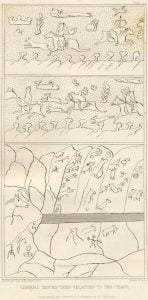
In directing attention to the nations of other parts of Asia, or of the globe, who have attracted notice for their picture-writing, the field of observation of the American continent itself is narrowed, it is believed, rather from the amount of materials we can command, or the space which travelers have devoted to it, than from the absolute non-existence of such materials. It was long thought that much of the writings of the engraved rocks of Wady Mohattah, in the group of Mount Sinai, of which specimens were furnished by Burckhardt and La Borde, were either picture-writing, or hieroglyphics, as no ancient alphabets could be found to solve them. The figures of camels, men, and other representative objects, were, at least, presumptive proofs of a mixed system. It is now announced, however, that modern research has overcome the obstacles to their interpretation, and that the alphabet of the larger inscriptions has been made out, although we have not yet, on this side of the water, been favored with the results. The pictorial objects still remain. The fact of the existence of these inscribed rocks had been known since 1722. By some the inscriptions have been supposed to be of the date of the 6th century, and to be the work of pilgrims visiting Mount Sinai; others have seen reason to assign a later date. It appears important to preserve a distinction between the mere pictorial and the alphabetic part of the various inscriptions, which are found to spread over separate faces of the rocks for many leagues. The former may often be regarded as illustrative of the latter; but it is by no means certain that they are, in all cases, parts of the same inscription, or are even of the same age. Writers have generally regarded the pictorial signs as of the earliest date; and the occurrence of such inscriptions in this portion of Asia is in coincidence with the supposed early prevalence of the practice in that primitive region of the human race. If Egypt and China did not profit by the advance of each other, in the first culmination of the pictorial in their respective systems of hieroglyphic signs, they may, reasonably enough, be thought to have derived their earlier ideas of it from that central quarter.
The ancient cuneiform or arrow-headed character of Persia has been long regarded as among the hieroglyphic enigmas of this part of the eastern hemisphere; but this has also yielded to modern research, and been found to reveal the true elements of a written character. It is among the tribes of the vast area which was covered by the Mongol, Tartar race, and by the Samoides of northern Asia, that we find the strongest remains of picture-writing.
The following transcripts are copied from the pages of the Swedish traveler, Strahlenberg, who first visited those countries about 1709, and published an account of his observations in the Low Countries, in 1722. 1 The first drawing is from the banks of the river Yenisei. Vide Figure C, Plate 64.
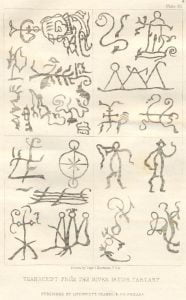
No explanation of it is attempted. The mere inspection of it denotes it to be one of those records of success in the chase, the communication of which, by pictures, is a common trait of roving and hunting bands. It takes its characteristic features from the natural history of the region; and we may suppose it to embrace rude representations of the Siberian hare, the cabarda or musk deer, and other known quadrupeds. Some of the under figures are manifestly symbolic, and five of them, inscribed above the figure of a heart, and bales of goods or baggage, are probably alphabetic.
The next specimen is from a precipitous rock on the river Irtish, a branch of the Nytza, Tartary. This rock, which is 36 feet high, has an isolated position. It has four sides, one of which faces the water, and has a number of tombs or sepulchral caves beneath. The figures which are here concentrated on a single folio cover, the four sides. They are drawn in red colors in a durable kind of pigment, which is found to be almost indestructible, and is much used for rock inscriptions. (See Figures 1, 2, 3, 4, Plate 65.)
In this inscription, we may suppose, there are some memorials of the persons entombed. They evince a curious mixture of the pictorial and hieroglyphic, and may at least be regarded as exhibiting the former in a state of transition. An opinion is expressed, which appears to be well founded, that they denote one of the earlier stages of the Chinese, which had been diffused into Tartary in the course of the wars and conquests carried on by these nations. Other specimens of such inscriptions are given from the vicinity of Tobolsk, which exhibit still more unequivocal proofs of the trans mutation of the character, and, indeed, leave but little trace of its origin in the pictorial method.

In the annexed rock inscriptions, Figure 4, Plate 66, which complete my quotations from this work, there are two striking coincidences with the North American pictures, in the style of drawing, and the symbolic combinations of thought. The first is the human figure. In this example we behold that combination of a bird and a man which, in so many of the preceding mnemonic figures of war and hunting, are designed to represent speed, and the power of superior knowledge by exaltation to the regions of the air.
In the line of fourteen crosses we recognize the North American symbol for men.
The figure beneath them, on the right, is a warrior on horseback, armed with a bow and arrow. On the left of this device, the two trees are evidently designed to symbolize medicinal plants. 2
In the drawings A and B, Plate 64, there is a strong resemblance to the free style of figuring, of which Mr. Cat in has furnished examples, as existing on buffalo-robes, among the tribes who posse horses, and hunt on horseback on the Missouri plains. In these Siberian sketches the hand of a higher grade of art is, however, manifest.
That the simple style of rock inscription, among the Mongolian and Tartar races of the eastern hemisphere, bears a marked resemblance to that of the red race of the western, is denoted in the following examples. (See figure 6, Plate 66, and figures 1, 2, 3, 4, Plate 67.) In figure 6, Plate 66, the drawing of a frocked man, with a heart lying at his feet, is suggestive of the office of a priesthood, among a barbarous people. The stems of shrubs, sprouting from one lobe of the heart, may symbolize a fragrant memory. The figures of high crosses raised upon a sort of rampart, appear to indicate towns, forts, or localities. The circle divided into eight parts, appears to be horologic. In figure 1, Plate 67, the deer stands as a simple symbol; in figure 2, of the same plate, the dart has the same value. In figure 3 of this plate, the reader is strongly reminded of a curious stone map, found on the sources of the Susquehanna, of which a transcript was published by the Historical Committee of the Pennsylvania Philosophical Society. In figure 4, as in some characters in figure 2, there is a strong tendency to the ancient rock-alphabet.
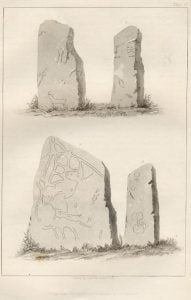
In the latter part of the 17th century, the government of Sweden employed a Mr. Scheffer, a professor of the University of Upsal, to travel into Lapland, to give a particular account of that but imperfectly-known part of the Swedish dominions. Amongst other subjects which he describes in his work, giving the results of this journey, he furnishes the following examples of their picture-writing, as illustrations of the ancient magical arts of the people, prior to the introduction of Christianity into Lapland. 3 The account which he gives of the ” magical ceremonies and arts of the Laplanders,” is a very curious chapter in the history of human superstitions; and exhibits, as a whole, a remarkable coincidence with the system of demonology existing under the name of medas, jossakeeds, wabenos, and professors of soothsaying and medical magic, in the western hemisphere.
Scheffer s figures are copied from the heads of the drums employed by the Lapland sorcerers and magicians. These drums are one-headed, consisting of a skin drawn tightly over a wooden hoop, and fastened with pegs. They are generally ovate, and differ much in size. They seldom exceed eighteen inches in diameter, and are often less. The figures are drawn on, or rather stained into the skin, by a red liquid or pigment, prepared from the bark of the alder. They are struck with a drumstick, or instrument resembling a ring. The music is accompanied with songs and incantations. In these songs their gods, spirits, or demons are addressed. The operators profess both to foresee and to produce events. They profess to furnish or allay winds on the sea; to cure or cause diseases; to perform magical journeys in the air, or under the earth; to influence the courses and ranges of wild or tame animals; and to exercise, without limitation, those powers which appertain to the ideas of witchcraft, sorcery, and magic.
Their principal deities are Thor and Storjunkare. The sun generally occupies the centre of the drum, surrounded by the moon, stars, birds, quadrupeds, reptiles, and various terrestrial or fabulous objects. The following transcripts, marked A and B, in the original work of Mr. Scheffer, exhibit two of the ordinary drums. Figure a represents Thor; b, his attendants; c, Storjunkare, arid d, his attendants; e, birds; f, stars; g, Christ; h, his apostles; i, a bear; k, a wolf; 1, a reindeer; m, an ox; n, the sun; o, a lake; p, a fox; q, a squirrel; v, a serpent. Here is, it will be observed, but little admixture of Christianity; it is merely taking into the number of things worshiped or relied on, or otherwise made the objects of occult energy, the name of Christ, showing the historical fact of the introduction of Christianity into the country at this period.
In the drawing B, a, denotes the Supreme Being; b, the Savior; c, the Holy Spirit; d, St. John; e, death; f, a goat; g,. a squirrel; h, heaven; i, the sun; 1, a wolf; m, a fish called scik; n, an owhr cock, or wild cock; o, friendship with the wild reindeer; p, Annundus Erici, the owner of the drum, being in the act of killing a wolf; q, gifts; r, an otter; f, a symbol of friendship with other Laplanders; t, a swan; v, a sign to try the disposition of others, and whether a distemper be curable; x, a bear; y, a hog; B, a fish; V, one carrying a soul to hell. What associations!
Each operator appears to be at liberty to introduce such figures as suit his fancy, belief, or superstitions. Geographical or astronomical visions are generally drawn on the painted skins by which there is supposed to be an association of objects deemed to be congruous.
A few general facts in the principles of pictorial notation of the Laplanders, may, however, be noticed. The sun bears its usual figure of a man s head, rayed. The same figure is used on a basis, representing a body, for the two gods Thor (who represent the great power of Good,) and Storjunckare, (the antagonistic power of evil,) and, also, on a cross, the same symbol stands for the servants of each god. Stars are re presented by two parallel lines, crossed at an acute angle by two similar lines, describing a rhomb in the centre. Birds are denoted by a simple skeleton of a body, and wings, making a cross. Death, by a monument crowned with a wreath. Various animals and reptiles by appropriate figures, as a reindeer, a squirrel, a serpent, a vulture. But these animals are generally mystified in their forms, and denoted by symbols which can only be interpreted by the sorcerer. Other symbols are wholly arbitrary, as a circle crossed, to denote gifts, waved lines to denote a lake, an ellipsis for friendship, &c. Much of each inscription would be wholly unintelligible without verbal explanation from an initiate in these mysteries. In Plate E, the figure of a closed cross, which is used on some of the North American inscriptions to denote death, occurs five times; but we have no interpretation of this. On Plate F there are no less than two-and-twenty figures, which may be supposed to have an alphabetical power. Both these inscriptions express, by division lines, the relative position of Sweden, Norway, and Lapland. They are, likewise, replete with figures of a frocked priesthood, clearly denoting the Christian church of the period.
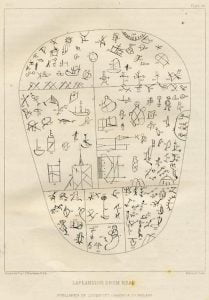
If, as has been remarked above, these examples denote a variety and want of uniformity in the symbols, or a great many homophonous characters, this fact is still further apparent in the subjoined transcript, Plate 68, which was copied in 1673 from one of the largest of the Lapland drums, then in the possession of Lawrence Althmack, a citizen of Stockholm. Fortunately, also, for the study of this subject, we have a full explanation of the characters and figures, by a Laplander, a native of Torna. Not less than one hundred and fifty characters are inscribed on this drum. They relate to necromancy, geography, natural history, law, medicine, astrology, demonology of the grossest type, and, in truth, every possible subject which could occur between the operator, or incantator, and the object of his incantations.
Figure number 1, is a symbol of Paul of Torna; 2, is the river of Torna, and 3, a tributary of it; 4, a weathercock, pointing to the north; 5, a symbol denoting God; 6, the sun; 7, the moon; 8, thunder; 9, a divine angel; 10, the angel Gabriel; 11, St. John; 12, St. Peter; 13, St. Matthew; 14, St. Martin; 15, St. Luke; 16, God s sergeant; 17, rain; 18, the light of the sun; 19, the wind; 20, good fortune; 21, bad fortune; 22, the earth; 23, water; 24, fire; 25, dedicated to sacrifices; 26, another form of the same altar; 27, the mountain Stateberg, a place of sacrifice; 28, the mountain Titro, also a place of sacrifice; 29, Sweden; 30, Prussia; 31, Holland; 32, England; 33, Spain; 34, France; 35, Cologne; 36, Turkey; 37, Lapland; 38, Finland; 39, the cities of Finland; 40, the cities of Sweden; 41, the cities of Ger many; 42, the village of the laborers; 43, war; 44, peace; 45, some persons going to church; 46, a great ship; 47, a shallop; 48, a Lapland idol; 49, the devil s boat; 50, the holy tree of the Laplanders; 51, a citizen; 52, his wife; 53, a countryman; 54, his wife; 55, a Laplander, or his wife; 56, the governor of Lapland; 57, the governor s gentleman; 58, a bailiff; 59, a Lapland church; 60, the church of the city of Torna; 61, the country church of the Lapmark of Torna; 62, the holy stone of the Laplander; 63, the trunk of the holy tree of the Laplanders; 64, a bear; 65., a cow; 66, an ox; 67, a wolf; 68, a reindeer; 69, a sheep; 70, a hog; 71, a horse with a long tail; 72,; 73, a swan; 74,; 75, a great wild cock; 76, a Laplander traveling in his sledge; 77, the mountain of Lapland dedicated to sacrifices; 78, a Lapland hut; 79, the most dangerous and malicious sorcerers; 80, a priest; 81, a man; 82, a squirrel; 83, a fir tree; 84, a pine tree; 85, a hare; 86, a fox; 87, the young of a reindeer; 88, a birch tree; 89, a cat; 90,; 91, a lake -or bog, with fishes and a boat; 92, a beaver; 93, an animal called jerf, or gouli; 94,; 95, a dog; 96, an oroskre, or ornokre, signifying the cast-off skin of a serpent; 97, a serpent; 98, a frog; 99, the god Nao; 100, the devil s ditch; 101, the genius of the mountains; 102, the hill of hell; 103, death; 104, an otter; 105, Lucifer; 106, Asmodeus; 107, a tyre, that is, a magical ball; 108, magical arrows; 109, denotes, it has happened according to the devil s will; 110, denotes the reverse, i. e. that it has happened contrary to the devil s intention; 111, the same devil; 112, his sergeant or officer, who attends constantly on his person; 113, the kettle of hell; 114, spectres; 115, 116, of hell; 117, the first president of the assembly of magicians; 118, the second president of the same assembly; 119, the third president of the same assembly; 120, the fourth president of the same; 121, the sorcerers going to their place of meeting with those children whom they instruct in magic; 122, the place where the sorcerers assemble, with their chief masters; 123, the district of Drontheim; 124, the gallows; 125, the prison; 126, the chief judge; 127, a symbol of the law; 128, the twelve judges; 129, the chamber where the judges sit; 130, the presiding judge; 131, a symbol denoting what is law; 132, a symbol denoting what is not law; 133, the feast of the nativity of Christ; 134, Easter day; 135, Whitsuntide; 136, the feast of; 137, St. Mary s, or midsummer day; 138, the day of the sun; 139, St. Eric s day; 140, St. John s day; 141, St. Peter s day; 142, St. James day; 143, St. Michael s day; 144, to denote an acceptable sacrifice; 145, symbolic of one who speaks truth; 146, those who are pernicious to the earth and to the waters; 147, death; 148, sickness; 149, a mortal wound given with a magical javelin; 150, device to denote an interdiction to sacrifice to any god of the mountains, to the trunk of a tree, or to a stone, because it will be vain and unsuccessful.
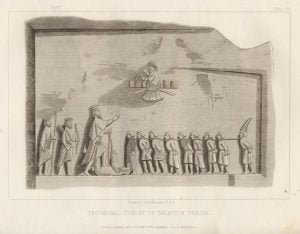
If a Lapland drum could speak, in magic tones, on so many subjects, it would seem to require, in order to give force to their expression, but the words of the incantation of the North American chief, (Vide ante,) “Hear my drum,” or the voice of the whole of these 150 diverse Lapland symbols, and images of things in heaven, earth, and hell, speaking at once. It has been stated that the cuneiform character has revealed the true elements of an alphabetical system. Some of its accompaniments were, however, representative or pictorial. Such is the triumphal record of the conquests of Darius on the rock of Belistun, as given by Major Rowlinson. 4 (See Plate 69.)
In this pictorial group the monarch is represented as the military conqueror of ten kings, nine of whom are chained together by the neck, and the tenth drawn prostrate, with the king s foot on his breast. Behind him stand his principal war-captains, drawn very much in the manner of the Mohawk chiefs who, in the Iroquois pictography, offer the chief-rulership to Atotarho. Above the group is represented the Persian god, Ormusd, who, by the ring about his body, and also by the circle in his hand, carries the symbol of eternity.
In the specimens of Iroquois pictography, which are now introduced, a style of drawing is observed which gives more muscular development to the human figure than is common with the remote forest tribes. In Plate 70, the first ruler of the tribes, under the confederacy, is depicted. Besides great military prowess, tradition gives him the reputation of a sorcerer or necromancer. The most noxious animals were harmless to him under the power of his charms; he is therefore drawn surrounded with rattlesnakes, who defend him on all sides. His perfect composure is shown by the calmness with which he indulges the pipe thus offering a species of frankincense to the spirit who sustained him. Before him stand two Mohawk war-chiefs, who offer him the simple staff of Iroquois sovereignty.


Plate 71. In this group we are presented with an Iroquois dancing party. The singer and drummer sits upon a stool. The dancers wield their clubs, and put them selves in the most contorted positions. It is a war-group. Wreaths depend from their elbows. Feathers decorate their heads. Their moccasins are cut like a ducal crown reversed.
Plate 72. National tradition, in this group, perpetuates one of its principal superstitions. It is that of the fairy flying heads an evident allusion to meteoric displays. Figure 4 embodies the main idea. Rays or flashes of fire are symbolized with a face and claws. A woman sitting and roasting chestnuts before the fire, with her dog, is mistaken, by this mysterious visitor, for a fire-eater. The act is considered paramount to his own.
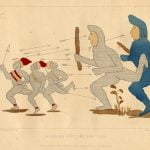
Plate 73. This plate represents the Stonish Giants a prime recital in Iroquois history. Who the giants are designed to symbolize is uncertain. They are represented as impenetrable by darts. Did ever an enemy, clothed in armor, visit this nation? Or, do the Stonish Giants symbolize the first enemy they met with firearms? The retreating warriors and the inefficacy of their darts are shown, as if they fled from mailed warriors.
We subjoin a specimen of the pictographic art for the tribes of Oceanica.
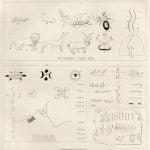
In Freycinet and Arago’s voyage to the Eastern Ocean, they obtained and published a specimen of the mode in which rude nations express their wishes pictorially, which may serve as an introduction to the less elementary method of the North American tribes. (See C, Plate 47). The author of this symbolical letter was a native of the Caroline Islands, a Tamor of Sathoual, who wished to avail himself of the presence of a ship to send to a trader at Rotta, M. Martinez, some shells which he had promised to collect in exchange for a few axes and some other articles. This he expressed to the captain, who gave him a piece of paper to make the drawing, and satisfactorily executed the commission. The figure of a man at the top denotes the ship s captain, who, by his outstretched arms, represents his office of a messenger between the parties. The rays, or ornaments on his head, denote rank or authority. The vine beneath him is a type of friendship. In the left column are depicted the number and kind of shells sent; in the right column the things he wished in exchange, namely, seven fish-hooks, three large and four small two axes and two pieces of iron. This request, the journalists state, was accurately fulfilled, and the exchange adjusted to the full satisfaction of the Tamor.
Citations:
- An Historico-Geographical. Description of the North and Eastern parts of Europe and Asia, but more particularly of Russia, Siberia, and Great Tartary, &c. By Philip John von Strahlenberg. London Ed. A.D. 1738. Drawn by Capt S Eastman.[
]
- In Figures 1 and 2, Plate 66, are given representations of two pieces of sculpture, which do not surpass the art that has been found to be displayed by numerous representations of birds and quadrupeds, covered upon the antique pipes of the Mississippi Valley.[
]
- The History of Lapland, containing a Geographical Description and a Natural History of that Country, with an Account of its Inhabitants, their Original Religion, Customs, Habits, Marriages, Conjurations, Employments, &c. Written by John Scheffer, Professor, &c. London Ed. 1704.[
]
- Royal Asiatic Society. “The Persian Cuneiform Inscription at Beliistun,” &c., by Major H. C. Rowlinson, C. B. of the Hon. East India’s Service, &c., London, 1846.[
]
